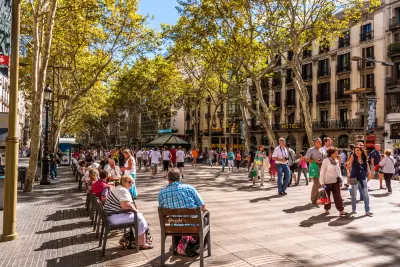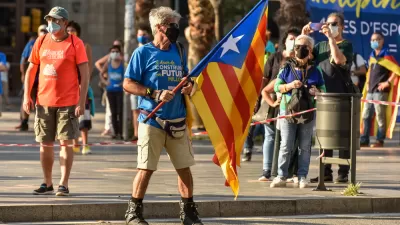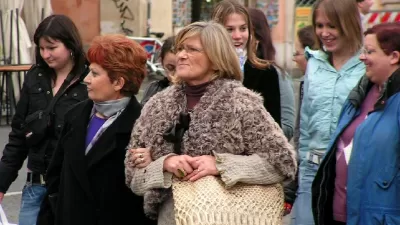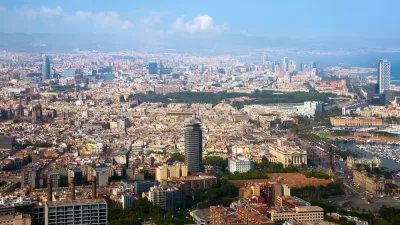Seeking relief from noise, pollution, and incessant traffic, the city of Barcelona has a bold plan to repurpose street space. "Superblocks" will route cars around the perimeter, leaving interior streets open for walkers and bikes.

Like many American cities, Barcelona devotes most of its road space to cars: "Private vehicles account for just 20% of total movements in the city today and yet they occupy 60% of roads." In pursuit of a 21% reduction in traffic, Barcelona's new mobility plan places heavy emphasis on the concept of superilles, or "superblocks." Marta Bausells discusses the ambitious plan in detail.
"In Eixample, a superblock will consist of nine existing blocks of the grid. Car, scooter, lorry and bus traffic will then be restricted to just the roads in the superblock perimeters, and they will only be allowed in the streets in between if they are residents or providing local businesses, and at a greatly reduced speed of 10km/h (typically the speed limit across the city is 50km/h, and 30km/h in specific areas)."
The city will roll out the superblock concept in series of gradual interventions, changing road signs and bus routes while leaving much of the streetscape intact. The superblocks idea has been around since 1987, and the first tests began in Barcelona in 2003. Currently, the idea is already being tested in nine districts via a trial-and-error process that has been called tactical urbanism.
The city hopes to achieve its 21% traffic reduction in two years, along with a corresponding shift to bikes, buses, and pedestrian trips. To get there, 300 km of new bike lanes are in the works.
FULL STORY: Superblocks to the rescue: Barcelona’s plan to give streets back to residents

Planetizen Federal Action Tracker
A weekly monitor of how Trump’s orders and actions are impacting planners and planning in America.

Congressman Proposes Bill to Rename DC Metro “Trump Train”
The Make Autorail Great Again Act would withhold federal funding to the system until the Washington Metropolitan Area Transit Authority (WMATA), rebrands as the Washington Metropolitan Authority for Greater Access (WMAGA).

The Simple Legislative Tool Transforming Vacant Downtowns
In California, Michigan and Georgia, an easy win is bringing dollars — and delight — back to city centers.

The States Losing Rural Delivery Rooms at an Alarming Pace
In some states, as few as 9% of rural hospitals still deliver babies. As a result, rising pre-term births, no adequate pre-term care and harrowing close calls are a growing reality.

The Small South Asian Republic Going all in on EVs
Thanks to one simple policy change less than five years ago, 65% of new cars in this Himalayan country are now electric.

DC Backpedals on Bike Lane Protection, Swaps Barriers for Paint
Citing aesthetic concerns, the city is removing the concrete barriers and flexposts that once separated Arizona Avenue cyclists from motor vehicles.
Urban Design for Planners 1: Software Tools
This six-course series explores essential urban design concepts using open source software and equips planners with the tools they need to participate fully in the urban design process.
Planning for Universal Design
Learn the tools for implementing Universal Design in planning regulations.
Smith Gee Studio
City of Charlotte
City of Camden Redevelopment Agency
City of Astoria
Transportation Research & Education Center (TREC) at Portland State University
US High Speed Rail Association
City of Camden Redevelopment Agency
Municipality of Princeton (NJ)





























